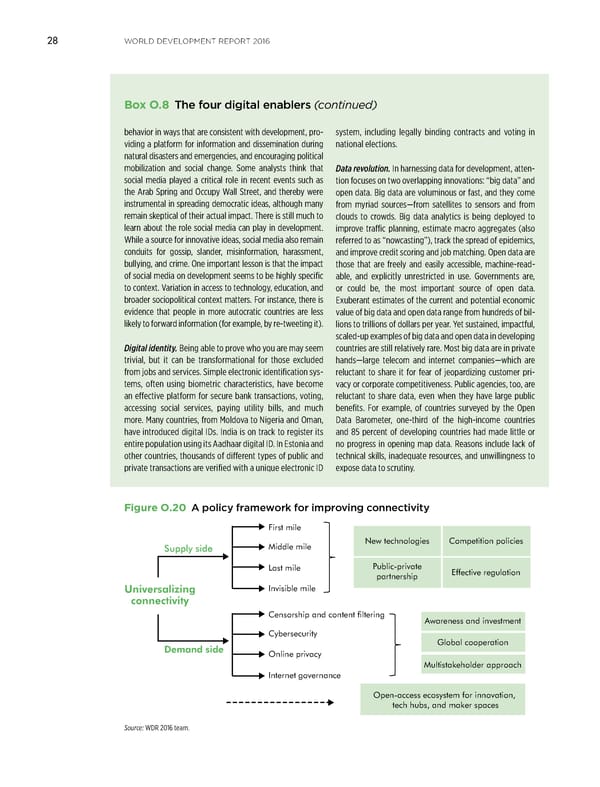WORLD DEVELOPMENT REPORT 2016 28 Box O.8 The four digital enablers (continued) behavior in ways that are consistent with development, pro- system, including legally binding contracts and voting in viding a platform for information and dissemination during national elections. natural disasters and emergencies, and encouraging political mobilization and social change. Some analysts think that Data revolution. In harnessing data for development, atten- social media played a critical role in recent events such as tion focuses on two overlapping innovations: “big data” and the Arab Spring and Occupy Wall Street, and thereby were open data. Big data are voluminous or fast, and they come instrumental in spreading democratic ideas, although many from myriad sources—from satellites to sensors and from remain skeptical of their actual impact. There is still much to clouds to crowds. Big data analytics is being deployed to learn about the role social media can play in development. improve traffic planning, estimate macro aggregates (also While a source for innovative ideas, social media also remain referred to as “nowcasting”), track the spread of epidemics, conduits for gossip, slander, misinformation, harassment, and improve credit scoring and job matching. Open data are bullying, and crime. One important lesson is that the impact those that are freely and easily accessible, machine-read- of social media on development seems to be highly specific able, and explicitly unrestricted in use. Governments are, to context. Variation in access to technology, education, and or could be, the most important source of open data. broader sociopolitical context matters. For instance, there is Exuberant estimates of the current and potential economic evidence that people in more autocratic countries are less value of big data and open data range from hundreds of bil- likely to forward information (for example, by re-tweeting it). lions to trillions of dollars per year. Yet sustained, impactful, scaled-up examples of big data and open data in developing Digital identity. Being able to prove who you are may seem countries are still relatively rare. Most big data are in private trivial, but it can be transformational for those excluded hands—large telecom and internet companies—which are from jobs and services. Simple electronic identification sys- reluctant to share it for fear of jeopardizing customer pri- tems, often using biometric characteristics, have become vacy or corporate competitiveness. Public agencies, too, are an effective platform for secure bank transactions, voting, reluctant to share data, even when they have large public accessing social services, paying utility bills, and much benefits. For example, of countries surveyed by the Open more. Many countries, from Moldova to Nigeria and Oman, Data Barometer, one-third of the high-income countries have introduced digital IDs. India is on track to register its and 85 percent of developing countries had made little or entire population using its Aadhaar digital ID. In Estonia and no progress in opening map data. Reasons include lack of other countries, thousands of different types of public and technical skills, inadequate resources, and unwillingness to private transactions are verified with a unique electronic ID expose data to scrutiny. Figure O.20 A policy framework for improving connectivity First mile Supply side Middle mile New technologies Competition policies Last mile Public-private Effective regulation partnership Universalizing Invisible mile connectivity Censorship and content filtering Awareness and investment Cybersecurity Demand side Global cooperation Online privacy Multistakeholder approach Internet governance Open-access ecosystem for innovation, tech hubs, and maker spaces Source: WDR 2016 team.
 World Development Report 2016 Page 42 Page 44
World Development Report 2016 Page 42 Page 44